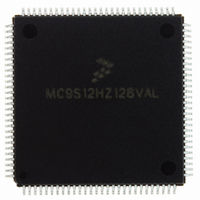MC9S12HZ128VAL Freescale Semiconductor, MC9S12HZ128VAL Datasheet - Page 329

MC9S12HZ128VAL
Manufacturer Part Number
MC9S12HZ128VAL
Description
IC MCU 16BIT 2K FLASH 112-LQFP
Manufacturer
Freescale Semiconductor
Series
HCS12r
Datasheet
1.MC9S12HZ128CAL.pdf
(692 pages)
Specifications of MC9S12HZ128VAL
Core Processor
HCS12
Core Size
16-Bit
Speed
25MHz
Connectivity
CAN, EBI/EMI, I²C, SCI, SPI
Peripherals
LCD, Motor control PWM, POR, PWM, WDT
Number Of I /o
85
Program Memory Size
128KB (128K x 8)
Program Memory Type
FLASH
Eeprom Size
2K x 8
Ram Size
6K x 8
Voltage - Supply (vcc/vdd)
2.35 V ~ 5.5 V
Data Converters
A/D 16x10b
Oscillator Type
Internal
Operating Temperature
-40°C ~ 105°C
Package / Case
112-LQFP
Processor Series
S12H
Core
HCS12
Data Bus Width
16 bit
Data Ram Size
6 KB
Interface Type
I2C/SCI/SPI
Maximum Clock Frequency
50 MHz
Number Of Programmable I/os
85
Number Of Timers
8
Maximum Operating Temperature
+ 105 C
Mounting Style
SMD/SMT
3rd Party Development Tools
EWHCS12
Minimum Operating Temperature
- 40 C
On-chip Adc
16-ch x 10-bit
Lead Free Status / RoHS Status
Lead free / RoHS Compliant
Available stocks
Company
Part Number
Manufacturer
Quantity
Price
Company:
Part Number:
MC9S12HZ128VAL
Manufacturer:
Freescale Semiconductor
Quantity:
10 000
Part Number:
MC9S12HZ128VAL
Manufacturer:
FREESCALE
Quantity:
20 000
- Current page: 329 of 692
- Download datasheet (4Mb)
11.7.1.4
A data transfer ends with a STOP signal generated by the 'master' device. A master transmitter can simply
generate a STOP signal after all the data has been transmitted. The following is an example showing how
a stop condition is generated by a master transmitter.
If a master receiver wants to terminate a data transfer, it must inform the slave transmitter by not
acknowledging the last byte of data which can be done by setting the transmit acknowledge bit (TXAK)
before reading the 2nd last byte of data. Before reading the last byte of data, a STOP signal must be
generated first. The following is an example showing how a STOP signal is generated by a master receiver.
11.7.1.5
At the end of data transfer, if the master continues to want to communicate on the bus, it can generate
another START signal followed by another slave address without first generating a STOP signal. A
program example is as shown.
11.7.1.6
In the slave interrupt service routine, the module addressed as slave bit (IAAS) should be tested to check
if a calling of its own address has just been received. If IAAS is set, software should set the transmit/receive
mode select bit (Tx/Rx bit of IBCR) according to the R/W command bit (SRW). Writing to the IBCR
clears the IAAS automatically. Note that the only time IAAS is read as set is from the interrupt at the end
of the address cycle where an address match occurred, interrupts resulting from subsequent data transfers
will have IAAS cleared. A data transfer may now be initiated by writing information to IBDR, for slave
transmits, or dummy reading from IBDR, in slave receive mode. The slave will drive SCL low in-between
byte transfers, SCL is released when the IBDR is accessed in the required mode.
Freescale Semiconductor
MASTX
END
EMASTX
MASR
LAMAR
ENMASR
NXMAR
RESTART
DEC
BEQ
MOVB
DEC
BNE
BSET
BRA
BCLR
MOVB
RTI
Generation of STOP
Generation of Repeated START
BSET
MOVB
Slave Mode
TST
BEQ
BRSET
MOVB
DEC
BRA
BCLR
RTI
TXCNT
END
IBSR,#$01,END
DATABUF,IBDR
TXCNT
EMASTX
IBCR,#$20
RXCNT
ENMASR
RXCNT,D1
D1
NXMAR
IBCR,#$08
NXMAR
IBCR,#$20
IBDR,RXBUF
IBCR,#$04
CALLING,IBDR
MC9S12HZ256 Data Sheet, Rev. 2.05
;DECREASE THE RXCNT
;LAST BYTE TO BE READ
;CHECK SECOND LAST BYTE
;TO BE READ
;NOT LAST OR SECOND LAST
;SECOND LAST, DISABLE ACK
;TRANSMITTING
;LAST ONE, GENERATE ‘STOP’ SIGNAL
;READ DATA AND STORE
;ANOTHER START (RESTART)
;TRANSMIT THE CALLING ADDRESS;D0=R/W
;GET VALUE FROM THE TRANSMITING COUNTER
;END IF NO MORE DATA
;END IF NO ACK
;TRANSMIT NEXT BYTE OF DATA
;DECREASE THE TXCNT
;EXIT
;GENERATE A STOP CONDITION
;RETURN FROM INTERRUPT
Chapter 11 Inter-Integrated Circuit (IICV2)
329
Related parts for MC9S12HZ128VAL
Image
Part Number
Description
Manufacturer
Datasheet
Request
R
Part Number:
Description:
Manufacturer:
Freescale Semiconductor, Inc
Datasheet:
Part Number:
Description:
Manufacturer:
Freescale Semiconductor, Inc
Datasheet:
Part Number:
Description:
Manufacturer:
Freescale Semiconductor, Inc
Datasheet:
Part Number:
Description:
Manufacturer:
Freescale Semiconductor, Inc
Datasheet:
Part Number:
Description:
Manufacturer:
Freescale Semiconductor, Inc
Datasheet:
Part Number:
Description:
Manufacturer:
Freescale Semiconductor, Inc
Datasheet:
Part Number:
Description:
Manufacturer:
Freescale Semiconductor, Inc
Datasheet:
Part Number:
Description:
Manufacturer:
Freescale Semiconductor, Inc
Datasheet:
Part Number:
Description:
Manufacturer:
Freescale Semiconductor, Inc
Datasheet:
Part Number:
Description:
Manufacturer:
Freescale Semiconductor, Inc
Datasheet:
Part Number:
Description:
Manufacturer:
Freescale Semiconductor, Inc
Datasheet:
Part Number:
Description:
Manufacturer:
Freescale Semiconductor, Inc
Datasheet:
Part Number:
Description:
Manufacturer:
Freescale Semiconductor, Inc
Datasheet:
Part Number:
Description:
Manufacturer:
Freescale Semiconductor, Inc
Datasheet:
Part Number:
Description:
Manufacturer:
Freescale Semiconductor, Inc
Datasheet:











